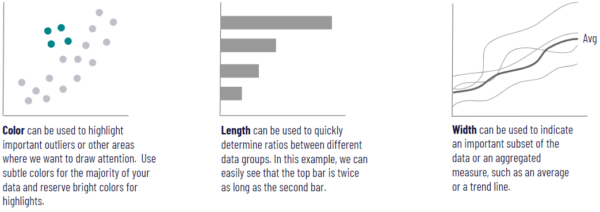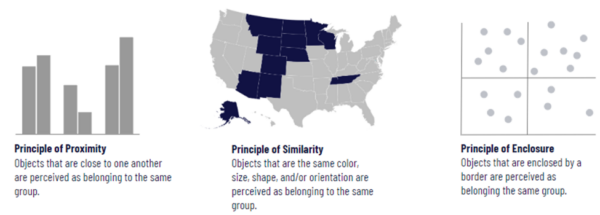We live in a world of data. Now more than ever, we rely on data to understand our businesses and make decisions in rapidly changing environments.
Simply looking at numbers isn’t the most efficient way to interpret data, especially if we have a lot of it. A better way is to translate data into graphical shapes or visualizations. According to Colin Ware in Information Visualization: Perception for Design, visual displays provide the highest bandwidth channel from the computer to the human brain. We have 20 billion neurons in our brains devoted to analyzing visual information and we acquire more information through vision than through all of our other senses combined.
Visualizations enable us to comprehend and internalize large amounts of data. However, not all visualizations are created equal. Some are more effective than others at presenting data in a way that allows us to quickly understand key insights. Below are four neuroscience principles that you can leverage to enhance your data visualizations.
Understand Visual Perception
The process of receiving visual information through our eyes and identifying and interpreting it in our brain is called visual perception. What our eyes take in and what our brain “sees” are two different things. If we understand how our brain receives and processes visual input, we can structure our visualizations so that the important patterns and relationships stand out, leading to improved understanding and faster speed-to-insight.
Leverage Pre-attentive Processing
To keep up with the flow of information streaming in from our eyes, our brains begin processing the visual input even before we are consciously aware of what we’re seeing. This is called pre-attentive processing. Pre-attentive processing is massively parallel and fast and is designed to detect certain visual attributes without conscious thought. Features such as color, shape, size, orientation and motion grab our attention without us consciously deciding to focus on them.
For example, take a look at the image below. Where does your attention focus first?

We “see” the red tulip first because our brains recognize it as different and flag it as something that requires our attention. Our brains pre-attentively look for differences in our visual input, bringing them to our conscious awareness.
This ability evolved as a survival mechanism; we needed to quickly detect a nearby predator in the tall grass or identify ripe fruit among the leaves in a tree. Now, we can take advantage of this mechanism in our data visualizations to rapidly draw attention to areas of importance. Here are a few examples:

Incorporate Gestalt Principles
In the early 20th century, Gestalt psychologists developed a set of principles to describe how we perceive visual patterns in groups of individual components. These principles are still used today and can be helpful in data visualization by providing extra context about the structure of the data. Let’s examine three of the principles and how we can apply them in a visualization:

Consider Cognitive Load
The more complex a visual image, the harder our brains have to work to understand and internalize the information in the image. In data visualization, we can assist with this process by simplifying our design, focusing on a few metrics at a time, and keeping our visualizations as clear as possible. The goal is to maximize what Stephan Few refers to as the “data-pixel ratio” by highlighting key insights in the data and eliminating or de-emphasizing non-data elements. Here’s an example:

When looking at any visualization, our brains must evaluate every element to determine its importance. In the “Before” graph above, the lines, axes and bolded titles are prominent and draw our attention away from the data, making it more difficult to quickly assess and extract insights from the visualization. In the “After” graph, the non-data elements have been either removed or de-emphasized, making the data much more noticeable and signaling to the brain what is most important in the visualization.
Visualizations are the most efficient way for us to internalize and interpret data. However, we can influence the utility of our visualizations and increase speed to insight by structuring our data in a way that takes advantage of how our brains perceive and interpret visual information. By utilizing these four neuroscience principles, your visualizations can become even more powerful.
Resources
- Information Visualization: Perception for Design by Colin Ware
- Information Dashboard Design by Stephen Few
- The Functional Art by Alberto Cairo
- Tim Wilson from Analytics Power Hour
About the Author
Paula Worley is a Senior Database Consultant at Sparq with over 12 years of experience in data analytics, data visualization and database development. She is also an RN with experience caring for patients on a busy cardiac floor in an inpatient hospital. She is passionate about crafting data into compelling stories that reveal trends, answer questions and assist in making business decisions. When she’s not working, Paula enjoys traveling, hiking, gardening and building her home apothecary as a novice herbalist.

Snowflake Summit 2025 Announcements
Snowflake Summit 2025’s latest announcements made it clear: the path to genuine AI-driven impact hinges on frictionless access to data, the ability to act on it with clarity, and absolute confidence in its protection. Learn more about how they're making that happen for customers in this article.

How ChatPRD Helps Build Better Stories (and a Stronger Team)
When user stories are vague, it slows down delivery, trust, and momentum. This article by Senior Product Strategy Consultant Traci Metzger shows how she used a lightweight, AI-guided system (ChatPRD) to write clearer, developer-ready requirements that actually accelerated execution.

QA in the Age of AI: The Rise of AI-Powered Quality Intelligence
As organizations push code to production faster, respond rapidly to new customer needs and build adaptive systems, the expectations on quality have changed. It's no longer enough to simply catch bugs at the end of the cycle. We’re entering an era where quality engineering must evolve into quality intelligence and organizations adopting quality intelligence practices are reporting measurable gains across key delivery metrics. Learn more in this article by Principal Engineer Jarius Hayes.

Operational Efficiency in the AI Era: What Matters and What Works
Ever wonder how leading teams are cutting costs without cutting corners? Hint: it starts with AI. In this article by Principal Delivery Manager Kabir Chugh, learn how AI is powering smarter ops, faster deployments, and measurable savings across industries.
